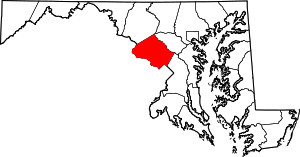Four Corners, Maryland
Four Corners is an unincoporated neighborhood located in Montgomery County, Maryland. Many residents of the Four Corners neighborhood, consider Four Corners to be a part of Silver Spring. The U.S. Census Bureau defines Four Corners as a distinct census-designated place.[1] Prior to the 2010 U.S. Census, it was defined as a part of the Silver Spring CDP.[2]
Location
Four Corners is bounded by Dennis Avenue to the northwest, the Sligo Creek Trail to the northeast, and Interstate 495 (Capital Beltway) to the south. It borders the neighborhoods of Northwood Park (also known as North Four Corners), Indian Spring Village, Franklin Knolls, Indian Spring Terrace, North Hills Sligo Park, and Burnt Mills Hills.
Landmarks
Located within Four Corners,[1] Montgomery Blair High School (MBHS)[3] is a public high school named after Montgomery Blair, the son of Francis Preston Blair, the founder of Silver Spring. Blair was a lawyer who represented Dred Scott in his United States Supreme Court case, and served as Postmaster General under President Abraham Lincoln. The school is nationally recognized for its magnet program and Communication Arts Program (CAP).
The Polychrome Historic District is a national historic district in the Four Corners neighborhood. It recognizes a group of five houses built by John Joseph Earley in 1934 and 1935.[4][5][6]
The land that comprises North Four Corners Park was first acquired in the mid-1940s. The park grew in size to 14 acres in 1998. The park features a recreation building, playground, ballfields, tennis courts and a picnic area.[7]
A number of historic homes exist in North Four Corners. These include the Silver Spring 1939 World’s Fair Home (House No. 15 in the 'Town of Tomorrow'), and the brick Tudor Revival Washington Gas Model Home that opened the 1938 building program in Northwood Park.[8]
History
Four Corners came into being as a residential neighborhood in the 1930s.[9]
Four Corners began as a 19th century agricultural community located at the crossroads on the Bladensburg and Colesville Roads. The community remained rural until the post-World War I building boom in suburban Montgomery County. Beginning in the late 1930s, Four Corners saw the development of Northwood Park, Woodmoor, Indian Spring Village, Indian Spring Terrace, North Hills of Sligo Park, and Fairway. These subdivisions expanded between 1945 and 1955 even as new ones, such as Northwood and Franklin Knolls, were constructed. The single-family house subdivisions that soon surrounded Four Corners had winding streets that formed an irregular grid in between major roads. Four Corners was largely developed by the late 1950s.[10]
References
- 1 2 "2010 CENSUS - CENSUS BLOCK MAP: Four Corners CDP, MD" (Archive). U.S. Census Bureau. Retrieved on June 22, 2015.
- ↑ "CENSUS 2000 BLOCK MAP: SILVER SPRING CDP" (Archive). U.S. Census Bureau. Retrieved on June 22, 2015. Detail 1 (Archive), Detail 2 (Archive)
- ↑ "Montgomery Blair High School". Mbhs.edu. Retrieved 2012-08-09.
- ↑ "John Kelly - Answer Man: Art Deco Homes Cast in Concrete". Washingtonpost.com. 2006-12-31. Retrieved 2012-08-09.
- ↑ "Art Deco Style Sparkles in Silver Spring". Washingtonpost.com. 2005-08-20. Retrieved 2012-08-09.
- ↑ "National Register Listings in Maryland". Mht.maryland.gov. Retrieved 2012-08-09.
- ↑ "Parks & Facilities Directory - North Four Corners Local Park". Montgomery Parks. Retrieved 2012-08-09.
- ↑ Rotenstein, David (1 October 2010). "Silver Spring World's Fair Home Featured at National Building Museum".
- ↑ "North Four Corners places and buildings collage | History Sidebar". Blog.historian4hire.net. 2010-12-30. Retrieved 2012-08-09.
- ↑ "Maryland Historical Trust" (PDF). mht.maryland.gov.
